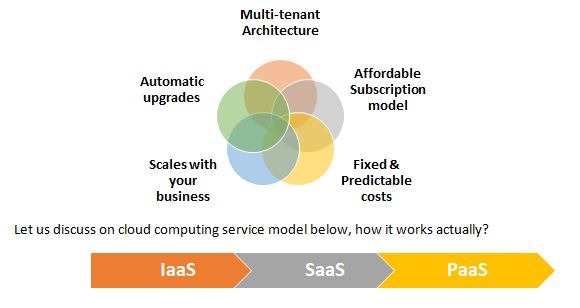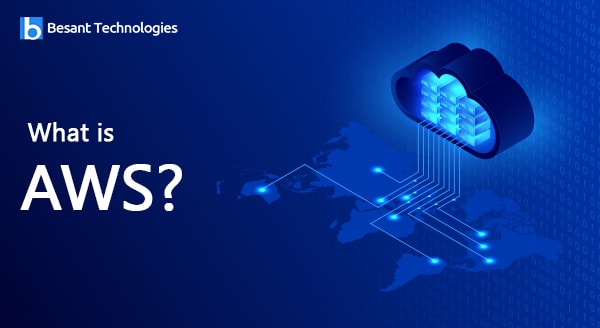
What is AWS?
What is Amazon Web Services?
Amazon Web Services is one of the world’s most wide-ranging and largely implemented cloud platform. You can get more than 175 services which are completely featured from different data centres universally. There are a ton of customers from various rapidly developing start-ups, major enterprises, and principal government interventions. AWS is helpful for these customers to reduce costs, making the concept more agile, and modernizing quickly. AWS is developed with a combination of presented by Amazon, which is developed with a combination of IaaS (Infrastructure as a Service), SaaS (Software as a Service) and PaaS (Platform as a Service) offerings.
Table of Content
1. Origin and Services of AWS
In the year 2002, It was in the year 2006 that Amazon started IT services to the market in the form of web services which got its name as cloud computing in the later years. In the usual scenarios, we need to pay for the servers and other IT infrastructure, but in Amazon web service (AWS) we pay for what we use. Every single second thousand servers are spinning simultaneously which will deliver the results faster.
AWS products include services like security, analytics, development tools, databases, storage, networking, migration, and enterprise applications. These services are distributed along with a pay-as-you-go pricing model. Before going to the deeper sessions, we need to know the basics of cloud computing.

2. What is AWS?
AWS is a subsidiary of Amazon.com that offers cloud computing services at very reasonable prices that is suitable for small scale businesses like Pinterest that has only 5 employees and Gmail that has millions of employees. Earlier when companies were using their personal resources to store or compute instances, there was a need for a global solution where you don’t have to buy resources every time but still, you can each of them. Here, the role of cloud computing came into the picture.
Now each Company has moved its data to the cloud to improve the performance and eliminating the backup issues too. In simple words, your data will never be lost even if you have not taken any backup. Since we need to adopt AWS in one or more ways, AWS being a major player in the industry here offering cloud services, so it makes sense to learn more about AWS and its related offerings too.
Here are a few insights that will make you realize why the adoption of AWS is so necessary by IT professionals worldwide.
- The growth of cloud computing will reach up to $150 B by 2020 or more.
- There are millions of jobs forecasted in the cloud computing field by experts.
- The cloud adoption has increased the revenue up to 40 percent or more during the last few years.
Based on these stats taken from the Gartner or Forbes, this is clear that AWS is the latest trend in the IT industry and it is expected to grow surely in the near future as well.
3. Advantages of AWS
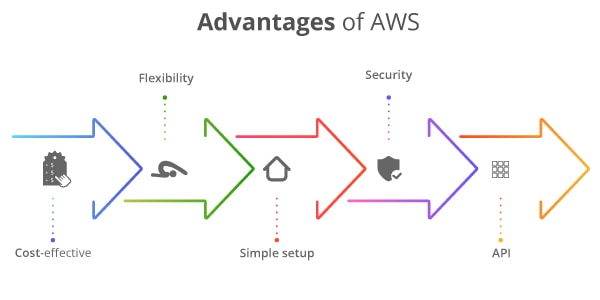
Below are the advantages of AWS:
3.1 Cost-effective
The payment can be done only for storage, compute power, and other resources without straightforward obligations or long-standing agreements. The pricing model for AWS is ‘pay for what you use’. Starting from hardware funds up-to infrastructure, AWS roll-out the price that appears throughout IT maintenance.
3.2 Flexibility
The entire process and workflows to receive the AWS services are quite easy and instant. This kind of easy procedure is just because of AWS’s broader programs, operating system, software architecture, and databases. As a technical person, you can be very much self-assured in conducting an immaculate transition during the IT infrastructure restructuring or a migration.
3.3 Simple Setup
To setup, the process of AWS and subscription will not take more than a day. An on-premise steadfast environment is not required for deployment as AWS is cloud-based. We have comprehensive documentation to run virtual servers and hence from preliminary step to deployment, the Management Console permits the developers to configure programs with excessive effectiveness.
3.4 Security
A lot of vindications are performed by Amazon to guarantee the uppermost values of data security. You can see a non-cooperated service delivery at the time of emergency, or when we can see a trigger in BCP (Business Continuity Plan).
3.5 API
Various programming languages are used in API which can be helpful in handling the infrastructure systematically. Through API, it is possible for you to launch a fresh instance or arranging for backups. When compared to the AWS Management Console, APIs are more powerful.
Learn AWS from the Basic to Advanced Level with Hands-on Training, Placements, and more with
AWS Training in Bangalore
4. Most important services of AWS
To work on application analytics and development, Amazon is affording various useful services. Below are some of the chief building blocks in the AWS environment and they are explained to get you to know the importance of each service.
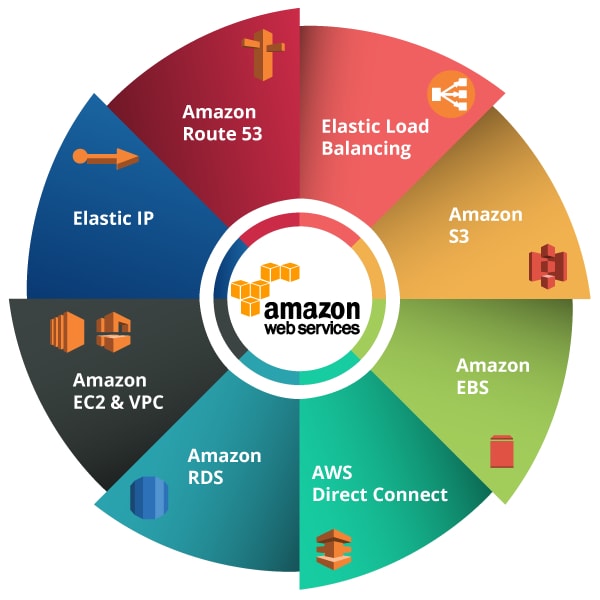
4.1 AWS Route 53
Amazon Route 53 is a mountable and extremely obtainable DNS (Domain Name System) service. Route 53 can be used to achieve the major three (3) functions which are health checking, domain registration, and DNS routing. These functions can be done in any combination, but if you are ready to perform these functions using Route 53, it is mandatory to follow the steps in order.
- Always a website needs a name, for example, google.com. So, the initial step is to register the website with a name. Hence, Registering the domain name comes as the first step.
- Once the domain name is set, you need to connect the website with the browser using Route 53 and that is where DNS routing takes place as the second step.
- The final step is to perform a health check on your resources. Automated requests are sent by Route 53 to your resources for the health check like availability, functionality, and reach ability. You are also allowed to opt notification if a resource is unavailable for any cause.
Amazon EC2 (Elastic Compute Cloud):
Computing is done in AWS by means of Amazon Elastic Compute Cloud (EC2) which are virtual servers called instances having computing capacity. It provides an auto-scaling tool to dynamically scale the capacity. The usage of EC2 and EC2 Container registry helps the customers to work with the docker containers and images on the platform of AWS.
EC2 is helpful for server hosting and configuration process. With the help of EC2, you can easily deploy your server. Amazon EC2 is a powerful web service affording resizable, protected, and great compute capacity in the cloud. Through this simple web service interface, you are permitted to acquire and construct the capacity with nominal resistance. You will be able to get the whole control of the computing resources and it is possible for you to run on the computing environment established by Amazon.
Computing economics can be modified by Amazon EC2 just by permitting to pay for capacity which is in actual usage. For building failure robust applications and segregate from public failure circumstances, Amazon EC2 has numerous tools to afford for the developers. We have the virtual computing environment in AWS which is called Instances. You can set up and configure the application and operating system which runs on the instance. Three types of instances are available namely Memory Optimized, Compute Optimized, and Storage Optimized.
4.2 Amazon Simple Storage Service (S3)
Storage is enabled by Amazon Simple Storage Service (S3) which provides rigid storage for data backup and analytics. Every file is stored as objects in this S3. A professional can store up to the range of 3GB in these S3 plots to tack in the right way. In the case of business, we can use Amazon Glacier which can store the data for long-term resembles the cold storage. Amazon Elastic Block Store is another service that offers cloud-based file storage.
Amazon S3 is a wonderful feature for data movement and storage purposes. We need to have scalable storage in order to construct a commanding cloud application. To effortlessly move and store the data all around the globe, Amazon S3 is good in affording all the necessary tools using buckets. You can designate the buckets in AWS in four different ways, which are Amazon Infrequent Access Storage, Amazon Reduced Redundancy Storage, Amazon Standard Storage, and Amazon Glacier.
4.3 AWS CloudWatch
AWS CloudWatch is helpful in monitoring services for your AWS environment. You can simply monitor the key resources like Amazon RDS DB instances, Amazon EC2 instance, Custom metrics generated by your applications and services, and Amazon DynamoDB tables. Gathering the logs through this process will enable you to get a complete perceptibility of the entire AWS components.
4.4 AWS CloudFront
For any type of service, we do in our business is to end up in the best user experience. Similarly, to deliver content at enhanced swiftness and reasonable price, AWS CloudFront comes into the picture which is a worldwide content delivery system. Through CloudFront, content is made very nearer to the users and as the content is served from the AWS region, user experience becomes more effective and quicker.
4.5 AWS ELB (Elastic Load Balancing)
We have an authoritative, and mountable load balancing feature in AWS called ELB (Elastic Load Balancer). If you need to send the client requests to the suitable servers and evade any available server hotspots, ELB plays a major role. There are two types of Load Balancing solutions in AWS, namely Application Load Balancing, and Classic Load Balancing. I hope you are aware that we need to pay for the services only for which we use. In that case, we need to do the payment for ELB based on the hour and the data processed quantity.
Apart from the above mentioned chief services of AWS, there are few services that are optional for the AWS users to enhance the cloud ecosystem.
- CloudTrail: AWS CloudTrail is helpful in capturing the primary information like event time, transactions, source IP address, and few more.
- AWS Config: Using AWS Config, your AWS infrastructure can be viewed with a keen eye and stay submissive and secured.
- Lambda: Lambda of AWS extracts the fundamental AWS infrastructure and permits developers to pay attention while running the code.
Get Placement Oriented AWS Training from Industry Experts with our AWS Training in Chennai
5. Master the AWS Services
5.1 Compute
It helps in processing data on the cloud with the help of powerful processors where multiple instances can be executed together.
5.2 Networking
With this service, you could integrate the security or access features to your business application.
5.4 Database
It helps in managing relational or non-relational database powered by the AWS.
5.5 Storage or Content Delivery
With this service, you could always store the data on the cloud anywhere but content delivery is used to cache data to the user with lower latency.
5.6 Management Tools
With the help of these tools, you could manage or check the progress of AWS instances.
5.7 Application Services
It includes services like queuing, emailing or notifications, etc.
5.8 Security
If you wanted to give access to a limited number of audiences then this is great using security features of AWS.
These services are given under the AWS account. You just have to register yourself on the AWS website and create a free account. Once an account is set up successfully then you can start using these services or instances in AWS based on your project needs. With this blog for What is AWS, now you have enough information about the topic and you can start using it for your next project immediately.
6. Top companies using AWS
There are many top companies that use AWS for their successful business, and they are listed below:
- Comcast
- Nasa
- Slack
- Novartis
- Lionsgate
- Nokia
- NetFlix
- Adobe
- Airbnb
- Time Inc
- Pfizer
- Yelp
- Samsung
- Expedia
- Dow Jones
7. Signup steps for free AWS Free trial
Users can use 12 months of AWS Free Trial with Hands-on experience. Building a website, storing your data, running the app, testing and developing apps are some of the major practical services available for the users. Below are the steps to get the free trial.
- Open the link “Amazon Web Services home page”.
- Select Create an AWS account and the signup page appears. If you already have an AWS account, you may need to click on “Sign in to an existing AWS account”.
- To create a new account, enter the email address, password, confirm password and AWS account name. Click “Continue”.
- The next step is to select whether this account is for Professional or Personal purposes. All the functions and features are similar for both the purpose.
- Based on the selection of the previous step, enter personal or company details.
- Now you must read and accept the Terms and conditions of AWS customer agreement.
- The final step is to click on “Create Account and Continue”.
- On completing these steps, you will receive an email for account confirmation.
- The next procedure is to add a payment method. Choose the required AWS support plan and make the payment. Now you can see a page indicating the account activation.
8. List of AWS Certifications
There are two major categories of certifications under AWS, which are AWS Specialty Certifications and AWS Core Certifications.
- AWS Specialty Certifications are AWS Certified Big Data, and AWS Certified Advanced Networking.
- AWS Core Certifications are further divided into 3 segments, which are Foundational, Associate, and Professional. AWS Certified Solutions Architect, AWS Certified SysOps Administrator, AWS Certified Cloud Practitioner, AWS Certified DevOps Engineer, AWS Certified Developer.
The starting salary for an AWS Engineers would be approximately $117,000 on completing Associate certifications and $125,000 on completing Professional certifications. The job roles available on completing AWS certifications are AWS Certified Developer, AWS Certified Solutions Architect, AWS Certified DevOps Engineer, and AWS Certified SysOps Administrator.
9. What is AWS? – Demystifying the Cloud Computing basics
This AWS tutorial is designed for professionals who are interested in learning cloud computing and wanted to become solution architects, AWS developers, engineers, or cloud experts in the near future. To learn AWS, you should know what is cloud computing first then we will discuss the AWS basics, its services, and price structure later.
Learn AWS Course to Boost your Career with our AWS Online Training
10. What is Cloud Computing?
Cloud Computing has become more popular these days in most of the companies just because of the necessity of a secure place to store data. Do you want to know what is Cloud computing? It is a computing service accessible through the internet where we have a huge collection of remote servers interacted to permit centralized data storage. Instead of an individual constructing, operating, and enlightening the infrastructure by own effort, it is very much helpful and effective to use Cloud computing in organizations where we can share the storage resources and computing
Cloud computing creates a web of remote servers that are worked on the internet basis having centralized data storage and the systems have got the chance to share the resources. It enables organizations to use the facilities rather than creating everything on their own. Clouds are of three types, public, private and hybrid. Regarding the service models, we have IaaS, PaaS, SaaS.
Cloud computing using resources from the web to store, manage, or process voluminous data instead of using your own servers. There are basically three major categories of cloud computing – SaaS, IaaS, and PaaS.
Some of the cloud computing attributes are given as below – Let us discuss on cloud computing service model below, how it works actually.
If we are talking about the AWS then it is more similar to the IaaS. Moving ahead we will discuss AWS in detail and why it is actually needed by businesses?
10.1 IaaS
IaaS stands for Infrastructure as a Service. It gives freedom to users to develop their own applications on the available resources. It means infrastructure as a service, if wanted to use infrastructure as a service for your next project then you could opt for this service model.
IaaS is a cloud computing platform, which was initially called Hardware as a Service (HaaS). IaaS is the service where the customer group outsources its IT infrastructure like networking, servers, storage, processing, virtual machines, and a few other resources. With the help of the pay-per-use model or cloud computing platform, customers can access these resources through the internet.
All the companies are getting the service IaaS in three (3) models which are private, public, and hybrid cloud. If using a public cloud, infrastructure is located at the cloud computing platform data center of the vendor. In the case of using a Private cloud, infrastructure exists in the place of the customer. Hybrid is a combination of both private and public based on the selection of customers.
IaaS allows the users to choose storage, memory, and CPU depending on the requirement. There is enormous computing power on the IaaS cloud platform which can be easily accessed by the users. The topmost IaaS providers are Sify, Rackspace, Netmagic Solutions, Tata Communications, Reliance Communications and Amazon Web Services.
10.2 PaaS
PaaS stands for Platform as a Service. As the name indicates the service provider will provide services likes queues, workflow engines, databases, etc. Using it, customers can create their own applications. If you wanted to use the platform as a service you could opt for this service model where PaaS means platform as a service.
The next useful cloud computing service if PaaS where we can get software and hardware tools from a third-party provider. Hosting the software and hardware on its own infrastructure is the speciality of a PaaS provider. Run a new application or installing in-house software and hardware can be avoided by the developer if using the PaaS service. PaaS is good at integrating numerous underlying cloud infrastructure components like databases, operating systems, servers, storage, middleware, and networking.
There are some additional resources provided by PaaS which are libraries, programming languages, database management systems, and few other development tools. To facilitate the users to install data sets and applications, an enhanced and robust environment is built and distributed by the PaaS provider. This is to enable the users to only focus on creating and running applications instead of building and preserving the fundamental services and infrastructure.
The underlying infrastructure is hidden in the PaaS architectures from its users and developers. All three types of clouds namely private, public and hybrid are used by PaaS to distribute services like Java development and hosting the application. There are few other PaaS services used by various organizations like Database integration, web service integration, Information security, and Application designing, development, and deployment. Different types of PaaS available for the developers are Private, Public, Hybrid, Communication, Open, and Mobile. Some of the important PaaS providers are Pivotal, Heroku, Oracle, IBM, Microsoft, Mendix, Red Hat, AWS and Google.
10.3 Saas
Saas stands for Software as a Service. Here the providers will give end-user applications to the customers with some administrative capability, which includes creating and managing the users. Customization is available here. It means the software as a service, if you need software resources from the web for your application then you can opt for this service model.
SaaS is one of the chief categories of cloud computing services. This is a very convenient software distribution prototype that is made available to the customers via the internet by a third-party provider. SaaS is meticulously correlated to the ASP (Application Service Provider) and a demanding computing Customers can easily acquire the network-based access and the source code of the application is similar for all the customers. If we get a new set of functionalities or features is the system, those are distributed to all the customers as well.
It is possible to store the data locally or in cloud-based on the Service Level Agreement. With the help of API, SaaS applications can be integrated with any software. SaaS is not only useful for big business, whereas we can utilize it for very basic technologies like sales management, financial management, billing, human resource management, email, CRM (Customer Relationship Management) and collaboration. SAP, Microsoft, Salesforce, Workday, IBM, ADP, ServiceNow, Google, Oracle, and Intuit are some of the principal SaaS providers.
Amazon Web Services (AWS) provides a mix of these three service models. AWS provides services from data centres that are located in different zones in the world. It is called Availability Zones (AZ). In each AZ, there will be multiple physical data centres. The AWS customer can sign up Virtual Machines (VMs) and can replicate the data.
The top services that are included in AWS are regarding the areas of computing, databases, application development, security, and infrastructure management.
10.3.1 Databases and Data management
Databases and Data management is done through Amazon relational database service which includes SQL Server, Oracle, Postgre SQL, MYSQL, Maria DB along with a high-performance system called Amazon Aurora. Amazon offers the best services through Amazon Dynamo DB. For the data analysts to perform the business-related tasks, they can use the data warehouse that is provided by the Amazon Redshift.
10.3.2 Application Services
Application Services is another great platform provided by AWS. The developer can take advantage of a software development kit (SDK) and AWS command-line tools to create and manage the applications. These SDKs are available for a number of programming platforms namely Java, PHP, Python, Node.js, Ruby, C++, Android, and ios. Amazon API gateway helps a developer to create and manage the applications easily. It has got the capability to manage thousands of concurrent APIs at once.
10.3.3 AWS Identity and Access Management (IAM)
Security is achieved by AWS by means of AWS Identity and Access Management (IAM) in which admins are deciding what should be accessed to the users. He can also create a user directory using the Amazon cloud collectively called as AWS Directory service. There are many other tools that inspect the security of other strict conditions. Amazon Inspector is one such tool that analyses the total environment. Another tool is Amazon Macie that uses machine learning technology to cover the data.
10.3.4 Internet of things (IoT)
Many other services are available through AWS which includes Internet of things (IoT) deployments, Amazon App stream, Amazon Workspaces, Amazon Workdocs, Amazon simple Email services, Amazon Simple Queue Service, Amazon Pinpoint, etc.
11. Cloud Types
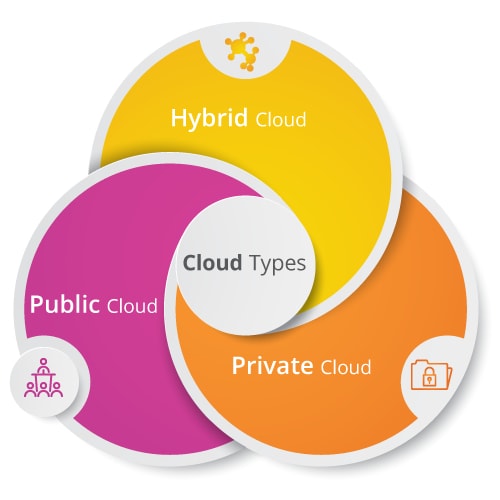
We have three (3) types of Clouds which are Private, Public and Hybrid.
11.1 Private Cloud
Through the private cloud, Organization manages the services and data. You can host your entire computing infrastructure by yourself and will not be shared. If using a private network, the control level and security become higher.
11.3 Public Cloud
When a third-party make services and resources obtainable for the customers through the Internet, it is said to have Public Cloud. The service provider’s infrastructure is responsible for the customer’s data and security.
11.4 Hybrid Cloud
A combination of both public and private cloud is the Hybrid Cloud. Companies should make the decision whether to use public or private based on different parameters like industry certifications and the necessary guidelines and values, etc.
We do have a few important features and services available with Cloud Computing. Lets us discuss the features now, followed by services as well.
12. Cloud Computing – Principal Features
12.1 Easy Maintenance
Using Cloud computing, it is very simple for the users to maintain the servers and we can see a very less downtime. In some cases, downtime is not even available. Update to the Cloud Computing happens regularly to get enhanced service.
12.2 Automatic System
Automated analysis of data can be performed easily through Cloud Computing. It is possible for you to control, monitor, and state the usage. Cloud Computing is good in providing transparency to both customers and hosts.
12.3 Security
Cloud Computing Security generates a screenshot of the stored data to avoid losing data when there is damage in the servers. As the data got stored in perfect storage devices, hacking is avoided and cannot be used by any other person.
12.4 Large Network Access
If a user has an internet connection and a device, then it is very simple to access the data from the cloud or even data uploading to the cloud from anywhere. There are no restrictions on the network as you can access from any type of network.
12.5 Resource Pooling
You can afford services to the various customers as Cloud providers will be able to pull the computing resources using the multi-tenant model. As per the customer demand, various virtual and physical resources are allocated and reallocated. Usually, customers do not have any information or control on the location of the provided resources but can identify the location at an advanced stage of abstraction.
12.6 Cost-effective
The company is expected to purchase only once for storage or a small portion of storage. This is to save the host from yearly or monthly charges. Just the basic maintenance must be taken care which would be very less.
12.7 Availability
The Cloud capabilities can be altered as per the requirement and it is possible to extend as much as possible. Based on the storage usage analysis, users can purchase additional Cloud storage when a small quantity is required.
13. List of Cloud Computing Certification
Below are some of the main Cloud Computing Certifications.
- Cisco Certified Network Professional Cloud
- Cisco Certified Network Associate Cloud
- Cloud Platform and Infrastructure
- Cloud Credential Council
- CompTIA Cloud Essentials
On completing the cloud certifications, a Cloud Architect can get an average salary of $128,000.

